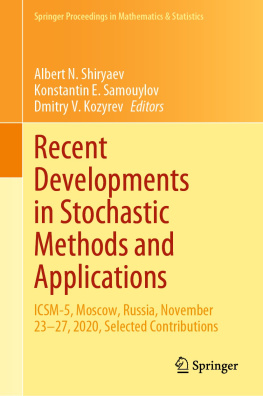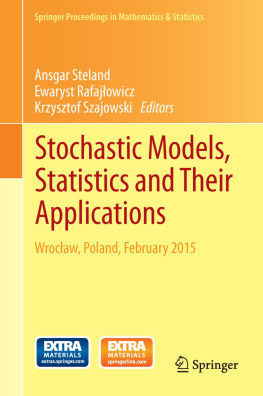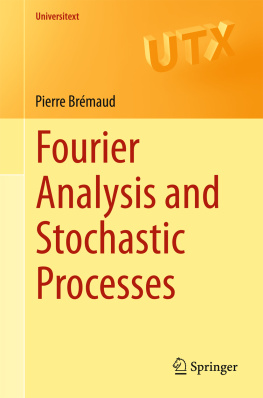U. Narayan Bhat - An Introduction to Queueing Theory: Modeling and Analysis in Applications
Here you can read online U. Narayan Bhat - An Introduction to Queueing Theory: Modeling and Analysis in Applications full text of the book (entire story) in english for free. Download pdf and epub, get meaning, cover and reviews about this ebook. year: 2015, publisher: Birkhäuser, genre: Home and family. Description of the work, (preface) as well as reviews are available. Best literature library LitArk.com created for fans of good reading and offers a wide selection of genres:
Romance novel
Science fiction
Adventure
Detective
Science
History
Home and family
Prose
Art
Politics
Computer
Non-fiction
Religion
Business
Children
Humor
Choose a favorite category and find really read worthwhile books. Enjoy immersion in the world of imagination, feel the emotions of the characters or learn something new for yourself, make an fascinating discovery.
- Book:An Introduction to Queueing Theory: Modeling and Analysis in Applications
- Author:
- Publisher:Birkhäuser
- Genre:
- Year:2015
- Rating:3 / 5
- Favourites:Add to favourites
- Your mark:
An Introduction to Queueing Theory: Modeling and Analysis in Applications: summary, description and annotation
We offer to read an annotation, description, summary or preface (depends on what the author of the book "An Introduction to Queueing Theory: Modeling and Analysis in Applications" wrote himself). If you haven't found the necessary information about the book — write in the comments, we will try to find it.
This introductory textbook is designed for a one-semester course on queueing theory that does not require a course on stochastic processes as a prerequisite. By integrating the necessary background on stochastic processes with the analysis of models, the work provides a sound foundational introduction to the modeling and analysis of queueing systems for a broad interdisciplinary audience of students in mathematics, statistics, and applied disciplines such as computer science, operations research, and engineering. This edition includes additional topics in methodology and applications.
Key features:
An introductory chapter including a historical account of the growth of queueing theory in more than 100 years.
A modeling-based approach with emphasis on identification of models
Rigorous treatment of the foundations of basic models commonly used in applications with appropriate references for advanced topics.
A chapter on matrix-analytic method as an alternative to the traditional methods of analysis of queueing systems.
A comprehensive treatment of statistical inference for queueing systems.
Modeling exercises and review exercises when appropriate.
The second edition of An Introduction of Queueing Theory may be used as a textbook by first-year graduate students in fields such as computer science, operations research, industrial and systems engineering, as well as related fields such as manufacturing and communications engineering. Upper-level undergraduate students in mathematics, statistics, and engineering may also use the book in an introductory course on queueing theory. With its rigorous coverage of basic material and extensive bibliography of the queueing literature, the work may also be useful to applied scientists and practitioners as a self-study reference for applications and further research.
...This book has brought a freshness and novelty as it deals mainly with modeling and analysis in applications as well as with statistical inference for queueing problems. With his 40 years of valuable experience in teaching and high level research in this subject area, Professor Bhat has been able to achieve what he aimed: to make [the work] somewhat different in content and approach from other books. - Assam Statistical Review of the first edition
U. Narayan Bhat: author's other books
Who wrote An Introduction to Queueing Theory: Modeling and Analysis in Applications? Find out the surname, the name of the author of the book and a list of all author's works by series.






![Dębicki Krzysztof - Queues and Lévy Fluctuation Theory [recurso electrónico] $c](/uploads/posts/book/193156/thumbs/d-bicki-krzysztof-queues-and-l-vy-fluctuation.jpg)




 for Poisson or exponential,
for Poisson or exponential,  for deterministic (constant),
for deterministic (constant),  for the Erlang distribution with scale parameter
for the Erlang distribution with scale parameter  , and
, and  for general (also
for general (also  , for general independent) we write:
, for general independent) we write: : Poisson arrivals, general service, single server
: Poisson arrivals, general service, single server : Erlangian arrival, exponential service, single server
: Erlangian arrival, exponential service, single server : Poisson arrival, constant service,
: Poisson arrival, constant service,  servers.
servers. be the number of customers in the system at time
be the number of customers in the system at time  . This number is the difference between the number of arrivals and departures during
. This number is the difference between the number of arrivals and departures during 